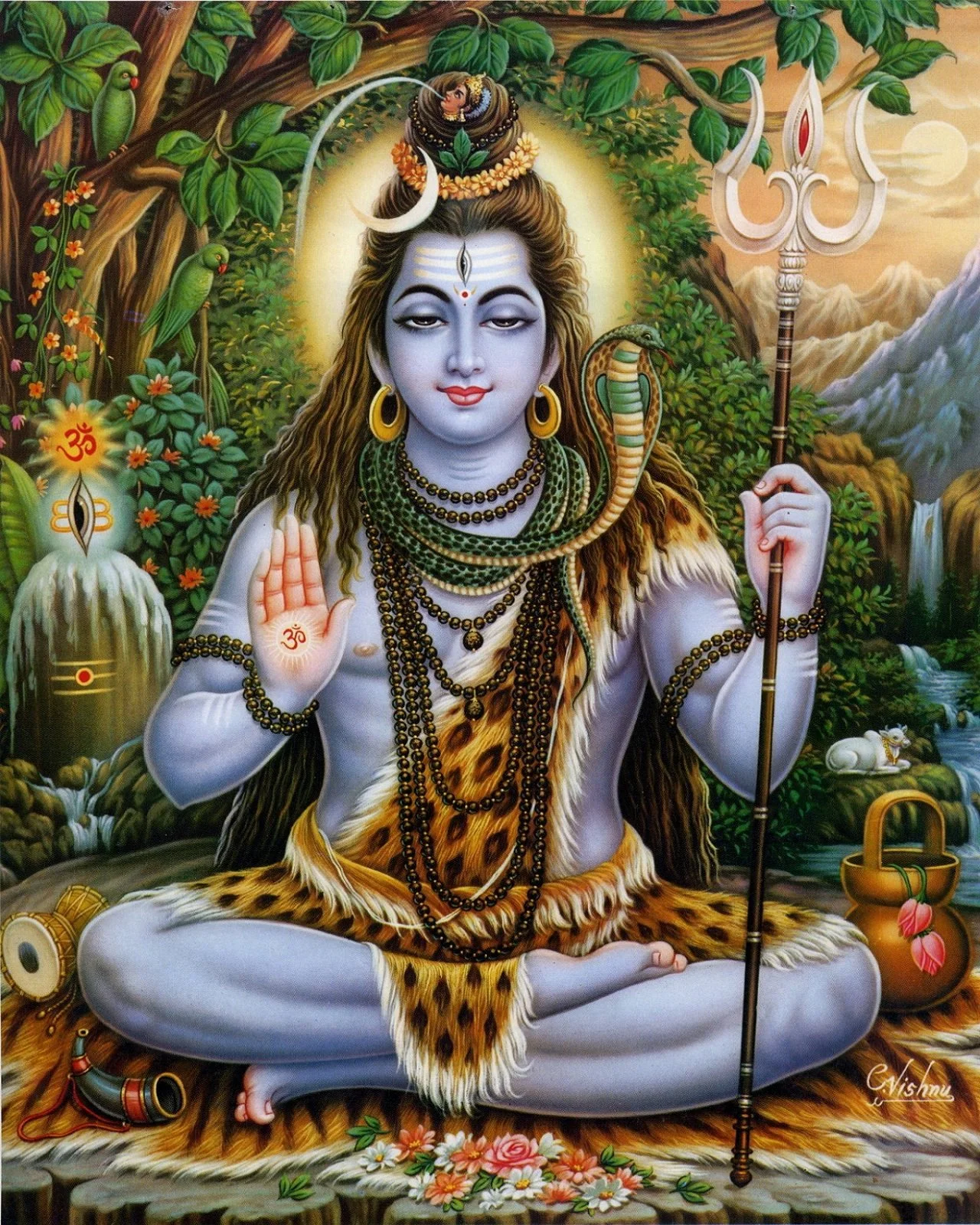Maha Shivaratri, the Celebration of Lord Shiva
Maha Shivaratri, also known as the Great Night of Shiva, commemorates “overcoming darkness and ignorance.” Hindus worldwide observe this occasion by celebrating Lord Shiva, the supreme god also known as the destroyer. He is one of the triple deities of supreme divinity in Hinduism, alongside Brahma, the creator, and Vishnu, the preserver. Shiva’s role is to destroy the universe—to rid illusions, imperfections, and negative human traits from the universe and then recreate it. Therefore, Shiva is a source of good and evil with many contradictory elements.
Lord Shiva is easily recognizable with a serpent around his neck, the crescent moon over his head, and the third eye on his forehead.
One of the most distinguished iconographical attributes of Shiva is that he wears a serpent around his neck. This serpent is Vasuki, the serpent king who vomited poison during the saga of The Churning of the Milky Ocean. Lord Shiva drank the poison to save the universe. As a result, Lord Shiva is sometimes depicted as having a blue throat. Other attributes of Lord Shiva are the adorning crescent moon on his head, the third eye on his forehead, his weapon, the trishula, and the damaru drum.
Maha Shivaratri falls on the 13th night or the 14th day of the Magha month (or the Phalgun month in northern India) in the Hindu calendar in February or March in the Gregorian calendar. Maha Shivaratri is important to many Hindus because they believe that praising Shiva during this time can liberate them from past sins or bad karmas. They also believe that Lord Shiva can help achieve moksha, the liberation from samsara, the cycle of birth and death. Since Shiva is regarded as the ideal husband, many women also partake in worshiping the supreme god during Maha Shivaratri. Married women pray to attain marital bliss and prosperous family life, and unmarried women ask to be blessed with a good husband.
An example of Shiva Lingam, an abstract representation of Shiva. 030 Shiva Lingham by Anandajoti is licensed under Creative Commons.
During Maha Shivaratri, devotees fast and begin the ritual by bathing and purifying themselves at dawn. Then, they dress in clean clothes before heading to the temple to bathe the Shiva Lingam, an abstract or aniconic representation of Shiva. Next, the Linga is soaked in milk and honey, and wood apples, or bale, which signify the purification of the soul. Finally, the devotees also apply the vermillion paste on the Lingam to signify virtue. Worship continues into the night, where devotees chant prayers and sing songs to praise Lord Shiva. Finally, they offer fruit, burn incense sticks, light oil lamps for the poojah, and spend the night fasting and praying.
Derek and I didn’t get to experience Maha Shivaratri during our time in Sri Lanka, but we visited Koneswaram Kovil in Trincomalee, one of the most significant Shiva temples in the world. Known as one of five abodes of Shiva, it is perched on top of the picturesque Gokarna Bay, located on the northeastern coast of Sri Lanka.
Derek and I visited Koneswaram Kovil in Trincomalee in 2020. It’s one of the most significant Shiva temples in the world.
The original date the temple was built is debatable. Some say it was made as early as 400 BC. Others claim the 5th century. Either way, the temple has been on the site for many years. During the Portuguese occupation in the 17th century, while the colonizers were busy razing religious sites, the monks threw many of the sacred objects from the temple into the ocean to protect them from destruction. Then, in 1956, photographer Mike Wilson and science-fiction author Arthur C. Clarke discovered the relics from the temple, including masonry, idol images, carved columns with flower insignias, and elephant head carvings, while scuba diving. The temple was restored to its former glory with all the recovered relics in 1963.
Wooden offering for Lord Shiva hung by women who pray for a child.
Derek and I visited the temple during the COVID pandemic. Sadly, we could not see the part of the temple that faced the bay. It also didn’t help that Derek wore shorts that day, so he wasn’t allowed inside the main temple. Since photography was strictly forbidden, I was only allowed to enjoy the colourful temple with intricate drawings with my eyes. Outside the main temple hung a collection of handmade wooden objects that looked like cradles tied with bits of bright fabric. I didn’t understand what they were before. Now, I realize that these are put up by women who wish for a child since Lord Shiva blesses devotees with marital bliss and prosperous family life.
Derek took a picture of me inside the temple while he stood outside.
When I visited Koneswaram Kovil in 2020, I hardly knew anything about Shiva. Now that I have some knowledge of Hindu deities and expected etiquettes while visiting temples, I feel like I would get so much more out of my visit. It would be wonderful to see the temple during Maha Shivaratri. I suspect as non-Hindu, we would only be allowed to watch the festivities from the outside as we did during the Nullar festival at the Nallur Kovil in Jaffna. Even from afar, the experience of watching the devotees perform their rituals and following their procession was awe-inspiring. I hope I will have the opportunity to experience it again.





